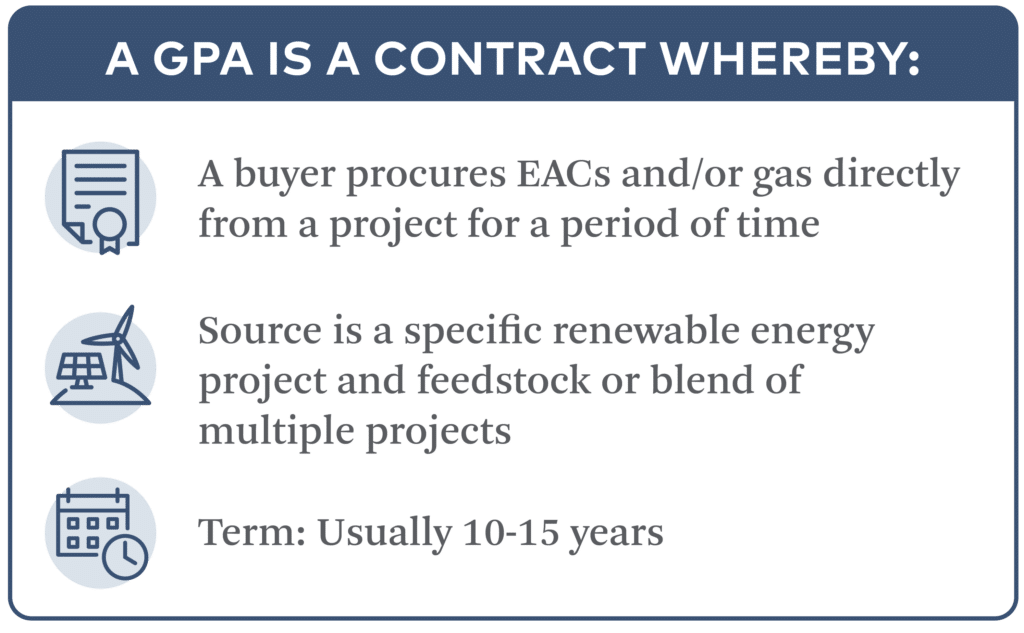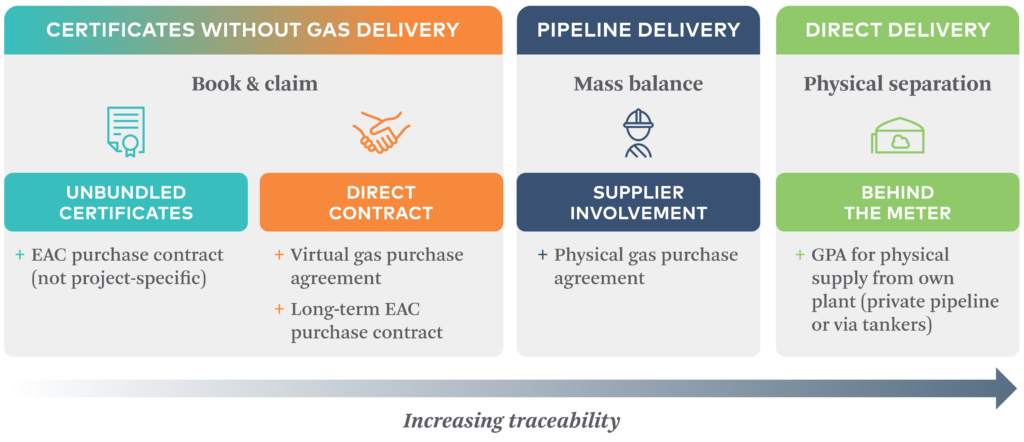Companies that have already purchased renewable electricity to address their scope 2 emissions are increasingly turning to renewable natural gas (RNG) as a way to tackle their natural gas emissions. RNG is a more sustainable alternative to natural gas that is produced from organic waste materials like agricultural residues, landfills, or wastewater treatment plants. Although the RNG and fossil-fuel gas molecules are indistinguishable from each other, the former provides a less carbon intensive alternative to conventional natural gas.
Similar to organizations using power purchase agreements (PPAs) to procure large amounts of renewable electricity, organizations are signing gas purchase agreements (GPAs) to do the same for RNG. In fact, GPAs have recently gained popularity as a procurement tactic to promote the deployment of RNG plants at scale.
Although there are numerous benefits to GPAs, there are also associated risks that are important to consider. In this blog, we discuss what GPAs are, their pros and cons, the types of companies that stand to benefit from them, and emerging industry guidance related to GPAs. 
A Brief Overview of Renewable Natural Gas (RNG)
RNG is bought and sold in voluntary and compliance markets in the US and in Europe (referred to as biomethane in Europe). When RNG is produced, both the gas molecules and an associated certificate are produced. These RNG certificates are referred to as renewable thermal certificates (RTCs) and can be procured using spot contracts or book and claim contracts — both allow a company to continue using their existing gas supply. Alternatively, a physical supply contract would include the gas in addition to the RTCs, or companies may also have onsite production of RNG by owning onsite digesters.
While all RTCs have a set climate benefit, the real world benefit of RNG could be enhanced through the choice of feedstock. Available RNG feedstocks vary, but include sources such as agricultural waste, livestock manure, municipal waste, and wastewater treatment facility effluent. The choice of feedstock impacts the sustainability and emissions reduction potential of the RNG and makes it possible for corporate buyers to select sources that align with their environmental and operational objectives. This choice can impact the price of RNG as it is determined by a number of factors, but is often tied to its emissions reduction potential.
To learn more about RNG feedstocks, carbon intensity, and other considerations for RNG, check out our recent blog post.
What is a Gas Purchase Agreement (GPA)?
A GPA is a contract through which companies can obtain RTCs from a specific renewable energy project or feedstock in a direct agreement with a project developer. There are many benefits to GPAs, which we’ll cover later in this blog, but to start, GPAs enable due diligence as the production process, site, and environmental impacts become visible to the buyer. To avoid double counting when procuring certificates from specific sites, the amount of RNG produced and its corresponding certificates must equal the amount claimed by the buyer.
As opposed to a one-off spot RTC purchase, GPAs are time bound and vary in term length (typically 7-20 years) — this can assist the buyer in procuring RTCs at a set price over that same time period.
Contract structures for GPAs are flexible and fall into three main categories:
- Book and Claim: In these agreements, buyers use a direct contract to obtain the RTCs, or other certificates representing the environmental attributes, produced by specific facilities; however, the RNG is not directly delivered to the buyer. These virtual structures consist of a contracted amount of RNG to be injected into the grid.
- Mass Balance: Under this structure, both the RNG and RTCs, or other certificates representing the environmental attributes, are delivered to the buyer. In this scenario, the buyer does not actually receive the RNG molecules from the facilities included in the GPA. Instead, the contracted volume from the facility is injected into the grid by the supplier and is mixed with the natural gas already in the pipeline. The buyer then withdraws an equal volume of natural gas elsewhere from the grid, while retaining the certificates.
- Physical Separation: Similar to onsite solar, an RNG facility is developed on the buyer’s premises, or close by, so the physical RNG molecules from the plant are consumed in their operations, leading to immediate GHG emissions reductions as it displaces conventional natural gas in the buyer’s supply. In some cases, the RNG is produced nearby and is trucked or piped in directly to the buyer. No certificates are needed since the gas is directly consumed.
Benefits of Gas Purchase Agreements
GPAs are proving to be instrumental in helping companies reduce their carbon footprint and achieve their sustainability objectives. The advantages of GPAs extend beyond emission reductions, offering six key benefits to companies that wish to further their climate action:
- Reduced Scope 1 Emissions: With some important caveats regarding reductions claims from the GreenHouse Gas Protocol (GHGP), RNG enables organizations to significantly reduce their carbon footprints and associated scope 1 emissions by replacing fossil fuel-based natural gas with gas from renewable sources. This shift supports environmental sustainability efforts while aligning with emission reduction goals.
- Supply Selectivity: Unlike spot purchases, GPAs allow buyers to choose specific RNG production facilities that best align with their objectives.
- Long-Term Viability: GPAs support the long-term viability of new RNG projects, offering greater climate benefits than typical spot purchases. By committing to GPAs, companies contribute to the growth of clean energy infrastructure and directly impact the available supply of renewables.
- Transparency and Accountability: GPAs facilitate direct engagement between buyers and producers, ensuring transparency in the procurement process. Buyers can conduct due diligence on selected RNG facilities, evaluating feedstock sources, operational practices, and environmental impacts for more accountable emissions reporting.
- Mitigation of Price Volatility: Buyers can mitigate gas price volatility through mass balance or physical separation GPAs if the contract price is fixed, though not if they are indexed. Whereas, book and claim GPAs may offer a hedge against a buyer’s retail gas purchasing strategy if the GPA settles against the same index. These hedged positions are crucial for companies looking to manage and forecast energy expenses, while reducing uncertainty related to price fluctuations. Furthermore, these GPAs offer a hedge against market movements for RTCs or other certificates representing the environmental attributes.
- Strategic Sustainability Planning: By aligning with reputable RNG suppliers, and selecting appropriate transaction structures and feedstock sources, companies can develop a strategic procurement strategy that aligns with their sustainability goals and operational requirements.
Overall, GPAs offer a holistic approach to RNG procurement, enabling companies to make tangible contributions to emissions reduction while supporting broader sustainability objectives. Although there are many benefits to utilizing GPAs, they might not be the ideal solution for every company. GPAs are best suited for organizations that have large scope 1 (direct emissions that are owned or controlled by the company) and have the funds to engage with the typically higher price point that RNG has over fossil fuel-based natural gas.
The Need for Certainty From Standards Bodies
Whether or not RNG can be used to address scope 1 emissions depends on how companies are procuring and using it. The Physical Separation method, where RNG is produced onsite, delivered via a dedicated pipeline, or transported by trucks (i.e., the RNG is not commingled with non-renewable fuels), is generally recognized by voluntary standards like the Greenhouse Gas Protocol (GHGP) and the Science-Based Targets Initiative (SBTi).
However, these groups have not yet finalized guidance on the use of certificates, like RTCs, to substantiate indirect RNG procurement. Initially, the GHGP stated that certificates or credits should not be used to address associated scope 1 emissions, but are now reconsidering their use in the future. SBTi currently does not allow the use of RNG certificates, such as RTCs. In the interim, organizations are advised by the draft guidance to report an average of the fuel mix in the pipeline (using a location-based approach) and report RTCs separately from the scopes.
There are three potential scenarios for the future of claiming RTCs and other RNG certificates against scope 1 emissions reductions. The GHGP could (1) permit the use of RNG certificates, (2) permit the use under strict conditions, or (3) prohibit the use of RNG certificates to reduce scope 1 emissions altogether. It is likely that whatever final decision the GHGP makes, other third-party frameworks like SBTi or RE100 will follow suit. Global agreement is that RNG is an important decarbonization tool for the future of our planet, especially for heating. Governments, consumers, and corporations want RNG, and GPAs in general, to be a more widely adopted solution.
For more on the implications of GHGP revisions on the use of RNG, see our related blog post.
A Crucial Net Zero Tool
RNG is increasingly recognized as a crucial tool for decarbonization, and GPAs are a large part of that solution. Companies considering sourcing RNG through GPAs should begin by developing a thoughtful procurement strategy. Buyers must engage reputable RNG suppliers, decide which transaction structure is right for them (e.g., physical or virtual), and choose feedstock sources that align with their sustainability goals and regional availability. Reviewing agreement terms, pricing, delivery schedules, and tenor is essential for making informed decisions – and expertise is required.
While the inclusion of different RNG procurement methods as acceptable GHGP scope 1 reduction tools depends on an organization’s reporting framework and evolving industry standards, buyers should stay informed about updates. 3Degrees is heavily involved in the voluntary and transportation markets, and is following the guidance around RNG closely.
Please reach out today to learn more about using GPAs to address your natural gas emissions or other RNG procurement strategies.




